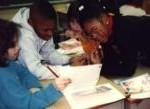“We shall not cease from exploration and the end of all our exploring will be to arrive where we started and know the place for the first time.” — T.S. Eliot
A few weeks ago I watched a group of first grade students use base ten blocks. I admired the fact that their teacher was using manipulatives to help her students understand place value. Her emphasis that week was on learning about tens.
I sat at the table and watched the students interact with the task. After a few minutes I picked up two longs (tens) and asked how much I was holding. Three students immediately yelled out 2. I followed their statements by asking two of what? They replied,
“Two sticks.”
What concerned me about the students’ responses was that I was pretty sure they didn’t understand, concretely, what a ten was. That is the reason why today’s blog is about making ten our “very best friend” by beginning with concrete experiences such as creating bean sticks and flats.
Let’s build some background (or attach to prior) knowledge before we get to the activity. What is meant by a concrete experience? Why begin there? The University of Kansas gives some good information regarding moving from the concrete-to-representational-to-abstract:
“The purpose of teaching through a concrete-to-representational-to-abstract sequence of instruction is to ensure students develop a tangible understanding of the math concepts/skills they learn. When students are supported to first develop a concrete level of understanding for any mathematics concept/skill, they can use this foundation to later link their conceptual understanding to abstract mathematics learning activities. Having students represent their concrete understandings (representational) by drawing simple pictures that replicate or mimic their use of concrete materials provide students a supported process for transferring their concrete understandings to the abstract level. Moreover, teaching students how to draw solutions to problem solving situations provides an excellent strategy for problem solving in the future.”
Their website has great definitions, too:
Concrete. Each math concept/skill is first modeled with concrete materials (e.g. chips, unifix cubes, base ten blocks, beans and bean sticks, pattern blocks). Students are provided many opportunities to practice and demonstrate mastery using concrete materials.
Representational. The math concept/skill is next modeled at the representational (semi-concrete) level, which involves drawing pictures that represent the concrete objects previously used (e.g. tallies, dots, circles, stamps that imprint pictures for counting). Students are provided many opportunities to practice and demonstrate mastery by drawing solutions.
Abstract. The math concept/skill is finally modeled at the abstract level (using only numbers and mathematical symbols). Students are provided many opportunities to practice and demonstrate mastery at the abstract level before moving to a new math concept/skill.
A few years ago, when I was teaching in a self-contained fourth grade classroom, many of my students had not developed good number sense. They could “regurgitate” the algorithmic procedures back at me, but they really didn’t know what a ten or a hundred was…so we spent days building them!
The Crafty Classroom has a really nice visual tutorial that includes pictures of how to make bean sticks. [http://www.thecraftyclassroom.com/CECraftToolsBase10.html]
My students were so engaged in their exploration of tens and hundreds that they asked if they could build a thousands block. It took a while, but they did it. They glued 10 of the hundred flats in a stack, put sticks around to support their stack, and created 1,000 beans. You know what the next sincere question was…
“Can we build 10,000?”
One of my most intense years of teaching was my sixth. I had moved from a suburban school to a very urban school with completely different challenges. I had so much more to learn. But I knew that by providing many concrete experiences with concepts my students’ number sense was growing. (And, for those of you who are crossing your arms and thinking “If you do so much hands on, what about the state tests?” My students made the highest scores in that grade that year and some of greatest improvements in the school.)
Those students helped make me the teacher I am today. They instilled in me a small voice that remains today. It regularly says,
“Remember me, I’m the student who won’t learn it the traditional way. What are you going to do for me?”
Can your students build 100? 1,000? 10,000? What will happen if they try?
“Jump into the middle of things, get your hands dirty, fall flat on your face, and then reach for the stars.” -Ben Stein


